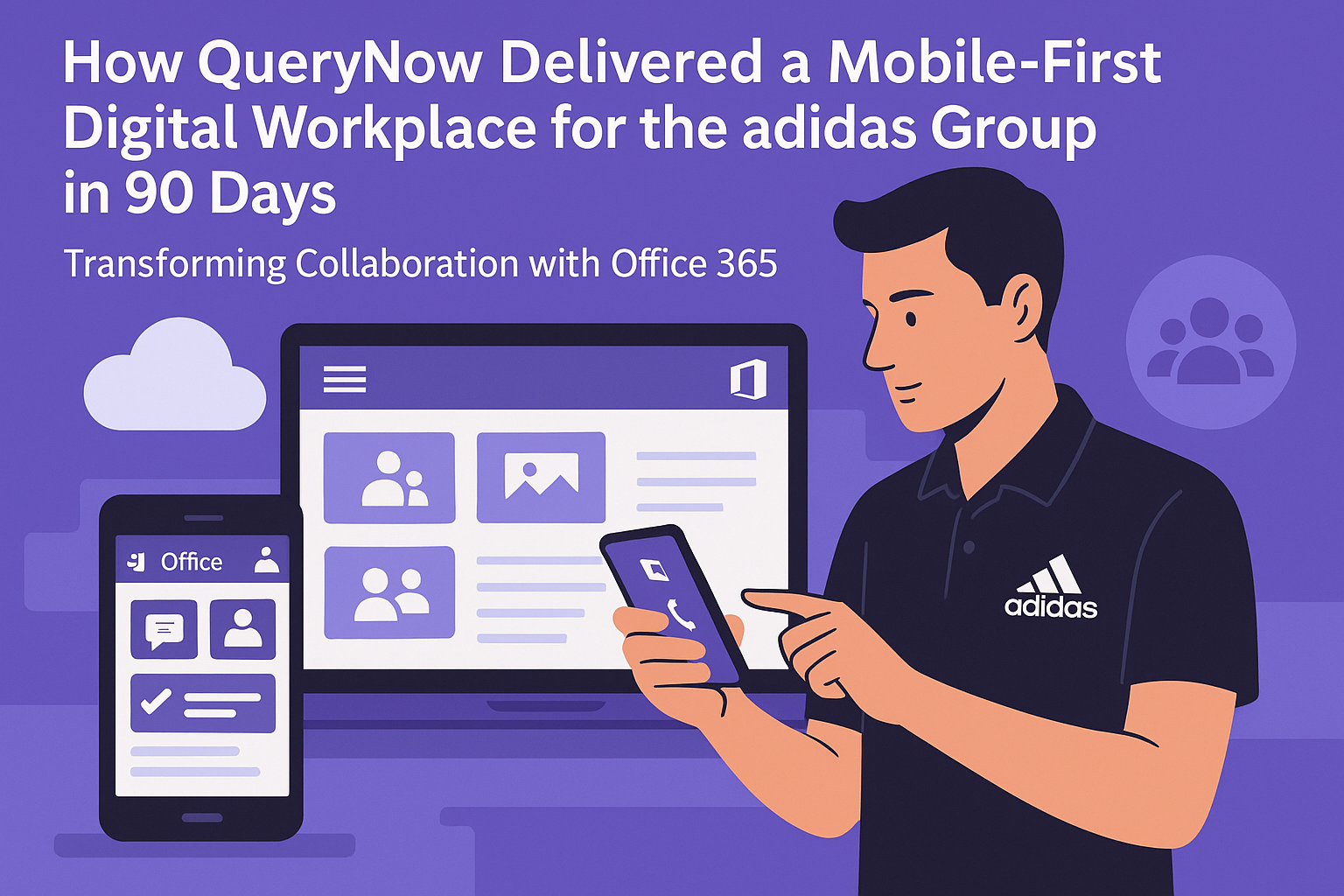
The Mobile-First Digital Workplace Imperative
The adidas Group, one of the world's largest sportswear manufacturers with over 60,000 employees across 160+ countries, faced a challenge common to global enterprises: their workforce was increasingly mobile, but their digital workplace was not. Sales representatives visited retailers daily. Marketing teams traveled to events. Supply chain managers split time between offices and distribution centers. All needed instant access to company information, collaboration tools, and business applications—but the existing intranet and collaboration platforms were desktop-centric, creating productivity gaps for mobile workers.
In an industry where speed-to-market and responsive collaboration drive competitive advantage, these limitations undermined business objectives. Leadership recognized that transforming their digital workplace to mobile-first was not optional—it was strategic imperative.
The Digital Workplace Challenge
adidas's legacy digital workplace exhibited common problems in organizations built around desktop computing:
Desktop-Only Intranet: The company intranet was not mobile-responsive. Mobile employees accessed limited information through workarounds or simply went without.
Email Overload: With limited collaboration platforms, email became the default for everything—drowning employees in messages and making information discovery nearly impossible.
Disconnected Tools: Multiple collaboration tools—file shares, document management systems, project spaces—created fragmentation. Finding information required knowing which tool to search.
Poor Mobile Access: Business applications and data were accessible primarily from office desktops, limiting field productivity.
Communication Delays: Company announcements and critical information took days to reach distributed workforce, particularly in retail and distribution environments.
The 90-Day Transformation Vision
Rather than a multi-year digital transformation program, we proposed an aggressive 90-day sprint delivering immediate business value while establishing foundation for continued evolution. The vision: a mobile-first digital workplace built on Office 365 that would enable employees to work effectively from anywhere while strengthening global collaboration.
Why 90 days? Speed created urgency, forced focus on highest-value capabilities, enabled rapid feedback cycles, and delivered ROI faster.
Solution Architecture and Capabilities
Mobile-First Intranet on SharePoint
We built a new company intranet on SharePoint Online with mobile-first design philosophy:
Responsive Design: Every page optimized for mobile, tablet, and desktop with layouts adapting automatically to screen size.
Touch-Optimized Interactions: Navigation and interactions designed for touchscreens, not mouse pointers.
Performance Optimization: Fast page loads even on cellular connections through image optimization and efficient code.
Offline Capability: Critical content available offline through mobile apps for environments with poor connectivity.
The intranet became truly mobile-accessible for the first time, giving field employees the same information access as office workers.
Microsoft Teams for Collaboration
We deployed Microsoft Teams as central collaboration hub, replacing email-heavy workflows:
Team Spaces: Dedicated collaboration spaces for departments, projects, and initiatives combining chat, file sharing, and meetings.
Mobile-First Experience: Teams mobile apps provided full functionality—chat, file access, meeting participation—from phones.
Integration Hub: Teams became central interface for business applications, reducing app-switching.
Real-Time Communication: Instant messaging and audio/video calling replaced lengthy email threads for quick decisions.
OneDrive and SharePoint for Content
Unified content management strategy:
Personal Content: OneDrive for Business giving each employee secure cloud storage accessible from any device.
Team Content: SharePoint team sites for departmental and project content with mobile access.
Co-Authoring: Real-time document collaboration from mobile and desktop Office apps.
Intelligent Search: Microsoft Search finding content across OneDrive, SharePoint, Teams, and email from single interface.
Mobile Apps Strategy
Comprehensive mobile app deployment:
Core Apps: Outlook, Teams, SharePoint, OneDrive, and Office mobile apps providing full mobile functionality.
Single Sign-On: Azure AD enabling seamless access to all apps with single login.
Security Controls: Mobile device management ensuring corporate data security on personal and company devices.
Conditional Access: Smart policies balancing security with user experience.
The 90-Day Implementation
Weeks 1-2: Planning and Architecture
We worked intensively with adidas stakeholders to define scope, priorities, and success criteria for the 90-day sprint. Key decisions included:
- Which business units to include in initial rollout
- Priority use cases and user personas
- Content migration strategy—what to move vs. archive
- Training and change management approach
- Success metrics and measurement strategy
The focused planning enabled rapid execution in subsequent weeks.
Weeks 3-8: Build and Configure
Parallel workstreams accelerated delivery:
Infrastructure Team: Office 365 tenant configuration, Azure AD setup, security policies, mobile device management, and conditional access rules.
Intranet Team: SharePoint site architecture, responsive page templates, navigation structure, and branding.
Content Team: Content audit, migration preparation, quality improvement, and new content creation.
Integration Team: Connections to HR systems, business applications, and existing collaboration tools for data migration.
Weekly demos to stakeholders ensured alignment and enabled course corrections.
Weeks 9-10: Pilot and Training
We piloted with the marketing department—mobile-heavy users with diverse needs:
Pilot Deployment: 500 users across multiple countries testing functionality in real-world conditions.
Feedback Collection: Surveys, focus groups, and usage analytics identifying issues and improvement opportunities.
Iterative Refinement: Daily fixes and enhancements based on pilot feedback.
Training Materials: Videos, quick-start guides, and FAQs developed based on pilot user questions.
Pilot validation provided confidence for full rollout and refined training approach.
Weeks 11-12: Global Rollout
Phased deployment by region and business unit:
Communication Campaign: Multi-channel announcements building awareness and excitement.
Training Delivery: Live sessions, recorded videos, and self-service resources for different learning preferences.
Support Readiness: Help desk training and additional support capacity for launch period.
Change Champions: Power users in each business unit supporting colleagues during transition.
Monitoring and Optimization: Usage analytics, support tickets, and feedback driving continuous improvement.
Week 13: Hypercare and Optimization
Post-launch week focused on ensuring smooth operation:
Enhanced Support: Extended support hours and additional resources addressing user questions.
Issue Resolution: Rapid response to problems, most resolved within hours.
Quick Wins: Fast implementation of high-value feedback items.
Success Measurement: Baseline metrics collection for ongoing optimization.
Results and Business Impact
Adoption and Usage
85% Mobile Adoption: Within 60 days, 85% of employees actively used mobile apps—unprecedented for adidas.
50% Mobile Usage: Half of all digital workplace interactions happened on mobile devices, validating mobile-first approach.
Daily Active Users: 75% of employees used digital workplace daily vs. 30% with legacy systems.
Productivity Improvements
60% Reduction in Email: Teams and modern collaboration reduced email volume significantly, saving hours weekly per employee.
70% Faster Information Access: Mobile access to intranet and documents eliminated delays when employees were away from desks.
Real-Time Collaboration: Teams enabled instant decision-making replacing email threads that took days.
Mobile Productivity Gains: Field employees reported 30% productivity improvement through mobile access to information and tools.
Business Agility
Faster Communication: Company announcements reached entire workforce in minutes vs. days previously.
Improved Coordination: Regional and global teams collaborated more effectively through Teams.
Rapid Response: Mobile workforce could respond to issues and opportunities immediately rather than waiting to return to office.
Cost Savings
Reduced Travel: Video meetings reduced travel requirements by estimated 20%.
IT Simplification: Consolidating on Office 365 reduced licensing and infrastructure costs.
Support Efficiency: Self-service capabilities and modern interfaces reduced support tickets 40%.
Critical Success Factors
Several factors enabled 90-day success:
Executive Sponsorship: C-level support provided resources, removed obstacles, and signaled organizational priority.
Ruthless Prioritization: Focusing on mobile-first core capabilities rather than trying to do everything enabled completion in 90 days.
Agile Execution: Two-week sprints with continuous stakeholder feedback allowed rapid iteration.
User-Centered Design: Mobile workers participated in design ensuring solution met actual needs.
Change Management Excellence: Comprehensive training and support drove adoption despite significant change.
Platform Leverage: Using Office 365 capabilities rather than custom development accelerated delivery.
Lessons Learned
Mobile-First Is Different from Mobile-Responsive: Mobile-first means designing for mobile constraints and capabilities from the start, not adapting desktop designs.
Pilot Is Essential: Real-world testing with mobile users revealed issues impossible to find in lab testing.
Change Management Cannot Be Afterthought: Training and support were as important as technology for adoption success.
Start Simple, Iterate Fast: Launching with core capabilities and enhancing based on feedback worked better than trying to anticipate every need upfront.
Quick Wins Build Momentum: Delivering value in 90 days created organizational confidence for continued digital workplace evolution.
Continued Evolution
The 90-day sprint was foundation, not destination. Post-launch enhancements included:
- Advanced Teams integrations with business applications
- Power Apps mobile applications for field processes
- Power BI mobile dashboards for executives
- Stream video communications platform
- Advanced security and compliance capabilities
The mobile-first foundation enabled rapid deployment of additional capabilities as needs emerged.
Getting Started with Mobile-First Transformation
If your organization has a mobile workforce but desktop-centric digital workplace—creating productivity gaps, communication delays, or competitive disadvantage—a mobile-first transformation can deliver rapid business value.
Ready to enable your mobile workforce? Contact QueryNow for a digital workplace assessment. We will evaluate your current capabilities, design a mobile-first strategy, and implement a modern digital workplace that enables productivity anywhere in a timeframe that delivers business results fast.


